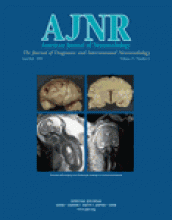Research ArticleBRAIN
Comparison of CT and Three MR Sequences for Detecting and Categorizing Early (48 Hours) Hemorrhagic Transformation inHyperacute Ischemic Stroke
Marie-Cécile Arnould, Cécile B. Grandin, André Peeters, Guy Cosnard and Thierry P. Duprez
American Journal of Neuroradiology June 2004, 25 (6) 939-944;
Marie-Cécile Arnould
Cécile B. Grandin
André Peeters
Guy Cosnard

Submit a Response to This Article
Jump to comment:
No eLetters have been published for this article.
In this issue
Advertisement
Marie-Cécile Arnould, Cécile B. Grandin, André Peeters, Guy Cosnard, Thierry P. Duprez
Comparison of CT and Three MR Sequences for Detecting and Categorizing Early (48 Hours) Hemorrhagic Transformation inHyperacute Ischemic Stroke
American Journal of Neuroradiology Jun 2004, 25 (6) 939-944;
Jump to section
Related Articles
- No related articles found.
Cited By...
- Determinants and Clinical Relevance of Iodine Contrast Extravasation after Endovascular Thrombectomy: A Dual-Energy CT Study
- Hemorrhage rates in patients with acute ischemic stroke treated with intravenous alteplase and thrombectomy versus thrombectomy alone
- Type of intracranial hemorrhage after endovascular stroke treatment: association with functional outcome
- Functional Outcome, Recanalization, and Hemorrhage Rates After Large Vessel Occlusion Stroke Treated With Tenecteplase Before Thrombectomy
- Association of initial imaging modality and futile recanalization after thrombectomy
- Dual energy CT after stroke thrombectomy alters assessment of hemorrhagic complications
- Agreement between core laboratory and study investigators for imaging scores in a thrombectomy trial
- Focal Low and Global High Permeability Predict the Possibility, Risk, and Location of Hemorrhagic Transformation following Intra-Arterial Thrombolysis Therapy in Acute Stroke
- Brain Edema Predicts Outcome After Nonlacunar Ischemic Stroke
- Suspicious Neuroimaging Pattern of Thrombotic Microangiopathy
- Substantial Observer Variability in the Differentiation Between Primary Intracerebral Hemorrhage and Hemorrhagic Transformation of Infarction on CT Brain Imaging
- Haemorrhagic transformation in acute ischaemic stroke following thrombolysis therapy: classification, pathogenesis and risk factors
- Angiogenesis Detected After Embolic Stroke in Rat Brain Using Magnetic Resonance T2*WI
- Asymptomatic Hemorrhage After Thrombolysis May Not Be Benign: Prognosis by Hemorrhage Type in the Canadian Alteplase for Stroke Effectiveness Study Registry
- Imaging
This article has not yet been cited by articles in journals that are participating in Crossref Cited-by Linking.
More in this TOC Section
Similar Articles
Advertisement











